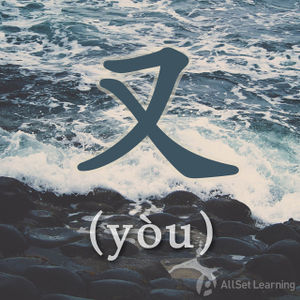Difference between revisions of "Expressing "both A and B" with "you""
m (Text replacement - "……" to "⋯⋯") |
|||
| Line 18: | Line 18: | ||
<div class="liju"> | <div class="liju"> | ||
| − | * 她 男朋友 <em>又</em> 高 <em>又</em> 帅。<span class="pinyin">Tā nánpéngyou <em>yòu</em> gāo <em>yòu</em> shuài. </span><span class="trans">Her boyfriend is both tall and handsome. </span> | + | *她 男朋友 <em>又</em> 高 <em>又</em> 帅。<span class="pinyin">Tā nánpéngyou <em>yòu</em> gāo <em>yòu</em> shuài.</span><span class="trans">Her boyfriend is both tall and handsome.</span> |
| − | * 这 个 房子 <em>又</em> 大 <em>又</em> 亮。<span class="pinyin">Zhè ge fángzi <em>yòu</em> dà <em>yòu</em> liàng. </span><span class="trans">This house is both big and bright. </span> | + | *这 个 房子 <em>又</em> 大 <em>又</em> 亮。<span class="pinyin">Zhè ge fángzi <em>yòu</em> dà <em>yòu</em> liàng.</span><span class="trans">This house is both big and bright.</span> |
| − | * 妈妈 的 头发 <em>又</em> 黑 <em>又</em> 亮。<span class="pinyin">Māma de tóufa <em>yòu</em> hēi <em>yòu</em> liàng. </span><span class="trans">Mom's hair is both black and shiny. </span> | + | *妈妈 的 头发 <em>又</em> 黑 <em>又</em> 亮。<span class="pinyin">Māma de tóufa <em>yòu</em> hēi <em>yòu</em> liàng. </span><span class="trans">Mom's hair is both black and shiny. </span> |
| − | * | + | *我 姐姐 <em>又</em> 聪明 <em>又</em> 漂亮。<span class="pinyin">Wǒ jiějie <em>yòu</em> cōngming <em>yòu</em> piàoliang.</span><span class="trans">My older sister is both smart and beautiful.</span> |
| − | * | + | *中国 菜 <em>又</em> 便宜 <em>又</em> 好吃。<span class="pinyin">Zhōngguó cài <em>yòu</em> piányi <em>yòu</em> hǎochī.</span><span class="trans">Chinese food is both cheap and good-tasting. </span> |
| − | * 你们 老板 <em>又</em> 年轻 <em>又</em> 有钱。<span class="pinyin">Nǐmen lǎobǎn <em>yòu</em> niánqīng <em>yòu</em> | + | *你们 老板 <em>又</em> 年轻 <em>又</em> 有钱。<span class="pinyin">Nǐmen lǎobǎn <em>yòu</em> niánqīng <em>yòu</em> yǒuqián. </span><span class="trans">Your boss is both young and rich.</span> |
| − | * 这里 的 咖啡 <em>又</em> 贵 <em>又</em> 难喝。<span class="pinyin">Zhèlǐ de kāfēi <em>yòu</em> guì <em>yòu</em> nánhē. </span><span class="trans">The coffee here is both expensive and bad-tasting. </span> | + | *这里 的 咖啡 <em>又</em> 贵 <em>又</em> 难喝。<span class="pinyin">Zhèlǐ de kāfēi <em>yòu</em> guì <em>yòu</em> nánhē. </span><span class="trans">The coffee here is both expensive and bad-tasting.</span> |
| − | * | + | *我 家 小狗 <em>又</em> 可爱 <em>又</em> 听话。<span class="pinyin">Wǒ jiā xiǎogǒu <em>yòu</em> kě'ài <em>yòu</em> tīnghuà.</span><span class="trans">My family's dog is both cute and obedient. </span> |
| − | * 上海 的 冬天 <em>又</em> 冷 <em>又</em> 湿。<span class="pinyin"> Shànghǎi de dōngtiān <em>yòu</em> lěng <em>yòu</em> shī. </span><span class="trans">Winter here in Shanghai is both cold and humid. </span> | + | *上海 的 冬天 <em>又</em> 冷 <em>又</em> 湿。<span class="pinyin">Shànghǎi de dōngtiān <em>yòu</em> lěng <em>yòu</em> shī.</span><span class="trans">Winter here in Shanghai is both cold and humid.</span> |
| − | * | + | *她 小时候 <em>又</em> 矮 <em>又</em> 瘦。<span class="pinyin">Tā xiǎoshíhou <em>yòu</em> ǎi <em>yòu</em> shòu. </span><span class="trans">She was both short and thin when she was young. </span> |
</div> | </div> | ||
Revision as of 08:34, 6 January 2017
-
Level
-
Similar to
-
Used for
-
Keywords
When you're getting descriptive, you may find yourself wanting to use multiple adjectives at a time. The character 又 (yòu) can be used to give two qualities to something. Using the double 又 (yòu) structure is like saying that something is "both… and… " in English.
Structure
The structure in Chinese is:
Subj. + 又 + Adj. 1 + 又 + Adj. 2
The two words shouldn't contrast in feeling. It is important to note they must both be bad or both be good.
Examples
- 她 男朋友 又 高 又 帅。Her boyfriend is both tall and handsome.
- 这 个 房子 又 大 又 亮。This house is both big and bright.
- 妈妈 的 头发 又 黑 又 亮。Mom's hair is both black and shiny.
- 我 姐姐 又 聪明 又 漂亮。My older sister is both smart and beautiful.
- 中国 菜 又 便宜 又 好吃。Chinese food is both cheap and good-tasting.
- 你们 老板 又 年轻 又 有钱。Your boss is both young and rich.
- 这里 的 咖啡 又 贵 又 难喝。The coffee here is both expensive and bad-tasting.
- 我 家 小狗 又 可爱 又 听话。My family's dog is both cute and obedient.
- 上海 的 冬天 又 冷 又 湿。Winter here in Shanghai is both cold and humid.
- 她 小时候 又 矮 又 瘦。She was both short and thin when she was young.



